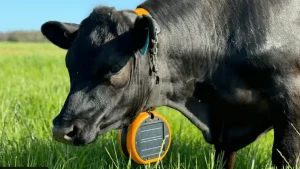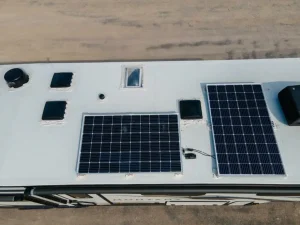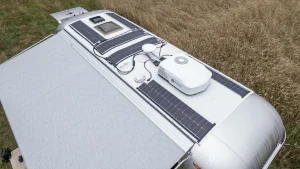The air conditioner is one of the appliances in a recreational vehicle that uses the most energy. People often think that setting up an RV solar AC system is hard, but it’s important for making travel comfortable in the summer. A lot of RV owners want to know, “Can solar panels really power an RV air conditioner?”
Yes, but you need to know about power demand, solar system design, and ways to make the system work better to get the whole picture. At Solar Energy Basics, the U.S. Department of Energy has a short guide to the basics of solar energy.
This article goes over the technical and practical parts of making a reliable RV solar AC system that works in the real world, which helps RV users get true off-grid comfort.
Can You Really Run an Air Conditioner on Solar Power in an RV?
Yes — but only if the system is correctly sized and configured. Both Sungold and Micro-Air confirm that an AC can run on solar power if the RV solar system is powerful enough to handle the load.
Running Power: 1,500–2,000 watts
Startup Surge: 3,500 watts or more
If your system cannot provide both sufficient solar input and energy storage, the AC won’t work reliably. This is why many RVers expand their rooftop solar arrays with extra battery banks and inverters.
What Makes Running an RV AC on Solar So Difficult?
Running an rv solar ac system is one of the toughest challenges for off-grid RV users. Air conditioners demand far more energy than most other onboard appliances, and this creates several barriers to making them work efficiently on solar power::
High Power Demand: Startup surge can be 3× running wattage. HVAC load fundamentals (ASHRAE) show how cooling loads directly translate into high electrical demand.
Weather Dependency: Performance drops on cloudy days, in shaded campsites, and during short winter days.
Roof Space Limits: Most RVs can only fit 600–1,200W of solar panels, often not enough for long AC use.
Battery Bottleneck: Without a large battery bank (several kWh per day), the AC will quickly deplete your reserves.
These challenges make a rv solar air conditioner one of the toughest off-grid applications.
What Components Do You Need for an RV Solar AC System?
A complete solar powered AC for RV setup requires more than panels:
Solar Panels: High-efficiency and sometimes flexible modules maximize limited roof space. A camper solar panel kit or portable solar power for RV can provide additional energy.
Battery Bank: Lithium iron phosphate (LiFePO₄) batteries are preferred for deep discharge, lower weight, and long life. Learn more at LiFePO₄ advantages for RVs.
Charge Controller: MPPT controllers extract up to 30% more power compared to PWM models.
Inverter: A pure sine wave inverter with at least 3,000–4,000W surge capacity ensures smooth AC operation.
Soft Starter: Devices like the Micro-Air EasyStart reduce startup surge by 65–75%, making solar-powered AC much more feasible.
How Do You Calculate the Energy Needs of an RV AC?
Daily Energy Use (Wh) = AC Running Power (W) × Hours of Use
Example: 1,500W × 5h = 7,500Wh (7.5 kWh) per day
Panels Needed = Daily Energy Use ÷ (Panel Wattage × Peak Sun Hours × System Efficiency)
Use tools like PVWatts solar production calculator (NREL) and local peak sun hours data (NSRDB).
With 400W panels, 5 sun hours, 75% efficiency:
7,500 ÷ (400 × 5 × 0.75) ≈ 5–6 panels
➡️ A typical RV solar AC system requires 2,000–2,400W of solar plus a large battery bank.
What Real-World Challenges Should You Expect?
Even if your system is properly sized, challenges remain:
Roof Space & Weight: Limited roof area requires flexible or portable solutions. Lightweight panels minimize RV load.
Initial Investment: Systems cost several thousand dollars. Long-term savings include less generator fuel and lower campground fees. For pricing benchmarks, see solar system sizing & costs.
Energy Management: Smart habits are key. Limit AC hours, use shades, and monitor usage with apps. Regional differences matter—see local climate normals (NOAA).
How Can You Improve Efficiency and Comfort with Solar AC?
Running AC on solar isn’t only about hardware — it’s also about optimization:
Maintenance: Keep solar panels clean; service AC filters and coils regularly.
Insulation: Use reflective curtains and insulation to reduce cooling demand. Consider high-efficiency air conditioners (ENERGY STAR).
Smart Monitoring: Apps track solar input, battery status, and power demand in real time.
Energy Strategy: Hybrid systems (solar + generator + shore power) increase reliability.
What Is the Best Solar Setup for an RV AC?
For most RV owners, an optimal setup includes:
2,000–2,400W of solar panels for RV (roof + portable)
5–7 kWh lithium battery bank
3,000–4,000W inverter
MPPT charge controller
Soft starter for surge reduction
This combination lets you run an rv solar AC for several hours per day in summer. For extended use, add ground-mounted panels and expandable storage. Always follow RV electrical safety (NEC) standards when wiring.
Is RV Solar AC Worth It?
Yes, you can run an AC on solar in an RV — but only with the right design.
High-efficiency panels, lithium storage, MPPT controllers, and a soft starter make it possible to enjoy quiet, generator-free, sustainable cooling.
While the upfront cost is significant, the long-term benefits—comfort, independence, and energy savings—make it worthwhile. A solar powered AC unit for RV is a real step forward for off-grid living.
👉 At Sungold Solar, we design solar system for RV solutions tailored to roof space, weight, and energy needs. Contact us to explore flexible, high-efficiency options for your RV.







